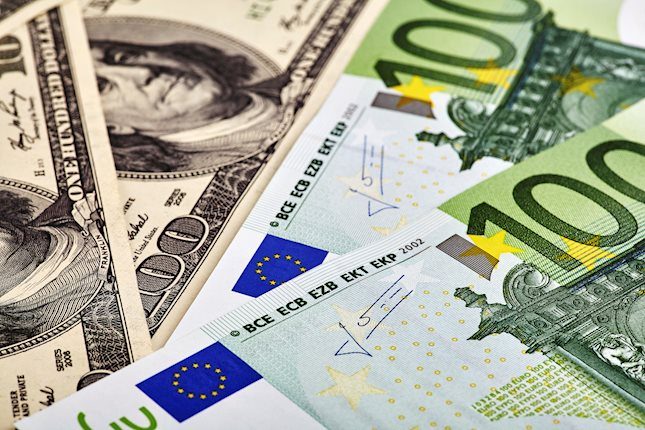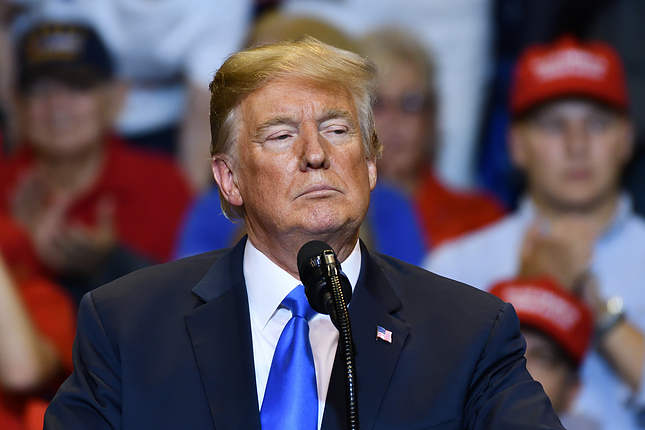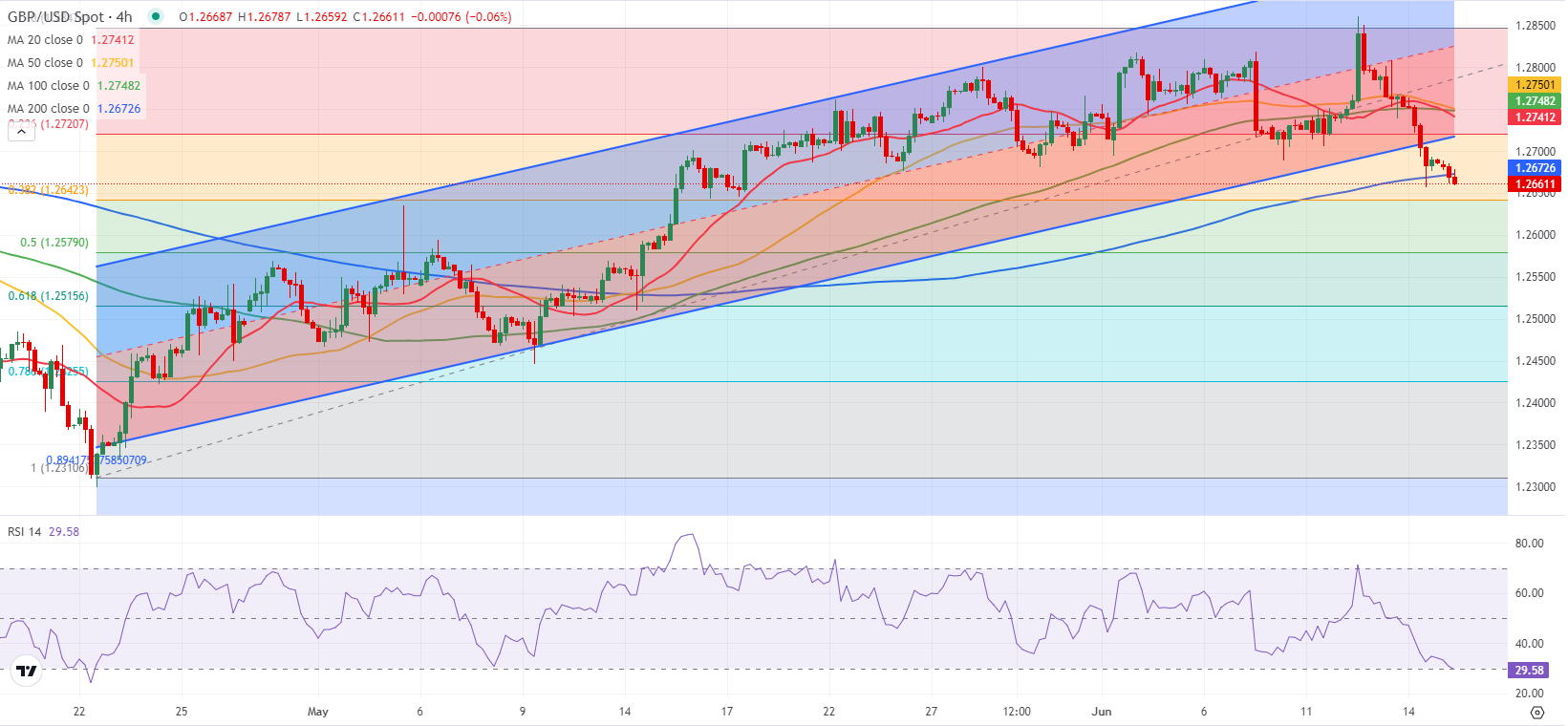- GBP/USD stays under modest bearish pressure and trades below 1.2700.
- The pair could face next important support at 1.2640.
- Risk perception and Fedspeak could drive the pair's action on Monday.
GBP/USD declined sharply on Friday and closed the previous week in negative territory. The pair struggles to gain traction on Monday and trades modestly lower on the day below 1.2700 in the European session.
British Pound PRICE Last 7 days
The table below shows the percentage change of British Pound (GBP) against listed major currencies last 7 days. British Pound was the weakest against the Swiss Franc.
| USD | EUR | GBP | JPY | CAD | AUD | NZD | CHF | |
|---|---|---|---|---|---|---|---|---|
| USD | 0.90% | 0.46% | 0.49% | -0.09% | -0.32% | -0.23% | -0.60% | |
| EUR | -0.90% | -0.09% | -0.15% | -0.72% | -0.94% | -0.86% | -1.23% | |
| GBP | -0.46% | 0.09% | 0.06% | -0.64% | -0.85% | -0.78% | -1.14% | |
| JPY | -0.49% | 0.15% | -0.06% | -0.58% | -0.89% | -0.83% | -1.04% | |
| CAD | 0.09% | 0.72% | 0.64% | 0.58% | -0.20% | -0.14% | -0.51% | |
| AUD | 0.32% | 0.94% | 0.85% | 0.89% | 0.20% | 0.08% | -0.30% | |
| NZD | 0.23% | 0.86% | 0.78% | 0.83% | 0.14% | -0.08% | -0.37% | |
| CHF | 0.60% | 1.23% | 1.14% | 1.04% | 0.51% | 0.30% | 0.37% |
The heat map shows percentage changes of major currencies against each other. The base currency is picked from the left column, while the quote currency is picked from the top row. For example, if you pick the British Pound from the left column and move along the horizontal line to the US Dollar, the percentage change displayed in the box will represent GBP (base)/USD (quote).
The broad-based US Dollar (USD) strength weighed on GBP/USD in the second half of last week. Although soft inflation data from the US revived expectations for a Federal Reserve (Fed) rate cut in September, the negative shift seen in risk mood helped the USD outperform its rivals.
The US economic calendar will not offer any data releases that could impact the pair's action in the American session. Hence, investors are likely to remain focused on risk perception and comments from Fed officials.
In the European session, US stock index futures trade mixed. Dow Futures are down 0.15% on the day, while Nasdaq Futures gain nearly 0.2%. In case Wall Street's main indexes struggle to find direction, GBP/USD could have a hard time staging a rebound.
Minneapolis Fed President Neel Kashkari said on Sunday that it is a “reasonable prediction” that the Fed will wait until December to cut interest rates. He further elaborated by noting that the central bank is in a very good position to get more data before making any decisions.
The CME FedWatch Tool shows that the probability of the Fed leaving the policy unchanged in September dropped to 33.3% from nearly 50% early last week, before the inflation data release. If more Fed policymakers voice willingness to wait until the end of the year before lowering the policy rate, the USD is likely to stay resilient against its major rivals. On the flip side, the risk mood could improve and GBP/USD stretch higher if Fed officials lean toward a policy pivot in September.
GBP/USD Technical Analysis
On the downside, 1.2640 (Fibonacci 38.2% retracement of the latest uptrend) aligns as next support before 1.2600 (psychological level, static level) and 1.2580 (Fibonacci 50% retracement).
GBP/USD could face interim resistance at 1.2700 before 1.2720, where the lower limit of the ascending channel meets the Fibonacci 23.6% retracement. In case the pair manages to stabilize above the latter, the 50-period Simple Moving Average (SMA) on the 4-hour chart could be seen as next recovery target at 1.2750.
Pound Sterling FAQs
The Pound Sterling (GBP) is the oldest currency in the world (886 AD) and the official currency of the United Kingdom. It is the fourth most traded unit for foreign exchange (FX) in the world, accounting for 12% of all transactions, averaging $630 billion a day, according to 2022 data. Its key trading pairs are GBP/USD, aka ‘Cable’, which accounts for 11% of FX, GBP/JPY, or the ‘Dragon’ as it is known by traders (3%), and EUR/GBP (2%). The Pound Sterling is issued by the Bank of England (BoE).
The single most important factor influencing the value of the Pound Sterling is monetary policy decided by the Bank of England. The BoE bases its decisions on whether it has achieved its primary goal of “price stability” – a steady inflation rate of around 2%. Its primary tool for achieving this is the adjustment of interest rates. When inflation is too high, the BoE will try to rein it in by raising interest rates, making it more expensive for people and businesses to access credit. This is generally positive for GBP, as higher interest rates make the UK a more attractive place for global investors to park their money. When inflation falls too low it is a sign economic growth is slowing. In this scenario, the BoE will consider lowering interest rates to cheapen credit so businesses will borrow more to invest in growth-generating projects.
Data releases gauge the health of the economy and can impact the value of the Pound Sterling. Indicators such as GDP, Manufacturing and Services PMIs, and employment can all influence the direction of the GBP. A strong economy is good for Sterling. Not only does it attract more foreign investment but it may encourage the BoE to put up interest rates, which will directly strengthen GBP. Otherwise, if economic data is weak, the Pound Sterling is likely to fall.
Another significant data release for the Pound Sterling is the Trade Balance. This indicator measures the difference between what a country earns from its exports and what it spends on imports over a given period. If a country produces highly sought-after exports, its currency will benefit purely from the extra demand created from foreign buyers seeking to purchase these goods. Therefore, a positive net Trade Balance strengthens a currency and vice versa for a negative balance.
Information on these pages contains forward-looking statements that involve risks and uncertainties. Markets and instruments profiled on this page are for informational purposes only and should not in any way come across as a recommendation to buy or sell in these assets. You should do your own thorough research before making any investment decisions. FXStreet does not in any way guarantee that this information is free from mistakes, errors, or material misstatements. It also does not guarantee that this information is of a timely nature. Investing in Open Markets involves a great deal of risk, including the loss of all or a portion of your investment, as well as emotional distress. All risks, losses and costs associated with investing, including total loss of principal, are your responsibility. The views and opinions expressed in this article are those of the authors and do not necessarily reflect the official policy or position of FXStreet nor its advertisers. The author will not be held responsible for information that is found at the end of links posted on this page.
If not otherwise explicitly mentioned in the body of the article, at the time of writing, the author has no position in any stock mentioned in this article and no business relationship with any company mentioned. The author has not received compensation for writing this article, other than from FXStreet.
FXStreet and the author do not provide personalized recommendations. The author makes no representations as to the accuracy, completeness, or suitability of this information. FXStreet and the author will not be liable for any errors, omissions or any losses, injuries or damages arising from this information and its display or use. Errors and omissions excepted.
The author and FXStreet are not registered investment advisors and nothing in this article is intended to be investment advice.
Recommended Content
Editors’ Picks

EUR/USD hovers around 1.0800 on Fed's decision
EUR/USD returned to the 1.0800 price zone after the Federal Reserve announced its decision to cut the benchmark interest rate by 25 bps as widely anticipated. Chair Jerome Powell's remarks put mild pressure on the US Dollar.

USD/JPY retreats from weekly highs as FOMC delivers 25 bps rate trim
USD/JPY hovers around 153.80 after the Fed broadly met market expectations on November's rate call. The Fed delivered a follow-up quarter-point cut on Thursday; markets now bet on the odds of a December three-peat.

Gold regains $2,700 with Fed’s announcement
Gold extends its recovery following Wednesday's sharp decline and trades above $2,700, as the US Dollar eases following the Federal Reserve's decision to cut rates by 25 bps. Powell's speech revolved around Trump's victory.

Ethereum Price Forecast: ETH eyes $3,366 as open interest growth could fuel quest for new all-time high
Ethereum (ETH) is up nearly 8% on Thursday and could reach a new all-time high before year-end following increasing investor demand for the top altcoin. This is visible in ETH's open interest growth and increasing Ethereum exchange-traded funds (ETF) inflows.

Outlook for the markets under Trump 2.0
On November 5, the United States held presidential elections. Republican and former president Donald Trump won the elections surprisingly clearly. The Electoral College, which in fact elects the president, will meet on December 17, while the inauguration is scheduled for January 20, 2025.

Best Forex Brokers with Low Spreads
VERIFIED Low spreads are crucial for reducing trading costs. Explore top Forex brokers offering competitive spreads and high leverage. Compare options for EUR/USD, GBP/USD, USD/JPY, and Gold.
